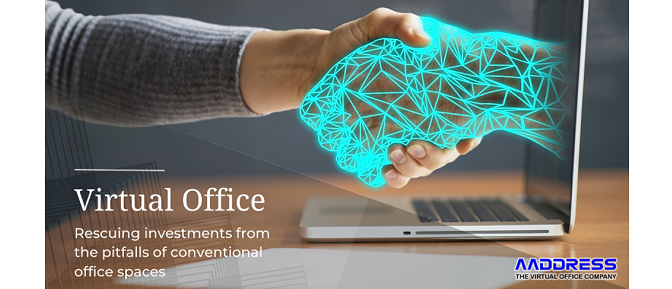In an era where technology constantly changes the way we live and work, virtual offices are rising as a catalyst, changing obsolete offices and bringing a new world of productivity, teamwork, and work-life balance.
As many companies have accepted work from home and digitalization, virtual offices are unleashing new potential, allowing employees to work from anywhere, anytime, and unlocking their full potential.
The market value of virtual offices is expected to increase from USD 40.51 billion in 2021 to USD 137.65 billion by 2029, with a CAGR of 16.52%.
Those days are gone when employees were bound to their chairs from 9 to 5. The virtual office has given more autonomy to employees and business owners over their work.
Businesses have the freedom to create their own work environment anywhere they want. Now your office could be a bustling metropolis, a comfortable café, or your own home.
Your workplace will be unique to your tastes and preferences.
A report issued by Maximum Market Research, a leading company in market research, says around 44 percent of companies have shuffled their offices to virtual offices post-Covid-19.
According to financeonline.com, 62% of employees are ready to switch companies to join a business that operates through virtual offices. This clearly indicates that the workforce is happier with the virtual offices. And it also reduces attrition rates in companies.
The other advantage of using a virtual office is cost reduction. Aaddress.in, The virtual office company says they have reduced up to 87% of the total cost of hiring and maintaining physical office space with their virtual office services.
Aaddress.in was established in 2018 and got its first client in 6 months. The reason behind so much delay was the rigid mind-set in the market that companies can only run effectively through physical offices.
In 2019, the company faces breaking the pattern in the market. And it succeeded in challenging the prevalent rigid mind-set.
COVID-19 was a blessing in disguise for Aaddress.in to prove the relevance and prowess of virtual offices.
In 2021, Aaddress.in was established as a leading brand in virtual office services, and according to reports, the company have 400 plus virtual offices across India in 2022.
In the fiscal year 2023-2024, the company is planning to start virtual office services outside India too. It is not confirmed yet, but CEO Ankur Goel has not denied the possibilities.
Coming back to the benefits of virtual offices:
A normal physical office setup may take days or even months, but a virtual office could be set up in minutes. With just a laptop and an internet connection, professionals can now seamlessly integrate their work and personal lives, achieving a healthier work-life balance.
This save money is giving economic advantages to the company opting for virtual offices.
By eliminating the need for a dedicated physical space, businesses can allocate their resources more efficiently, investing in other critical areas such as talent acquisition, product development, or marketing strategies.
This cost-saving approach has proven to be particularly beneficial for startups and small businesses looking to scale their operations without breaking the bank.
The other benefit is an increase in productivity among employees. Employees have shown a 13% increase in productivity in the first nine months of working in virtual offices.
The reason behind increased productivity is a sense of autonomy and freedom. With more freedom at work, employees can unleash their creativity.
Moreover, virtual offices foster a collaborative environment, even in a remote setting. Advanced communication and collaboration tools, such as video conferencing, instant messaging, and project management platforms, enable teams to stay connected, share ideas, and work together seamlessly.
Also, with cost reduction, virtual offices have proven to be time savers for both employees and companies. Commute time is saved. The cost and time of travelling, meetings, and conferences are also saved due to virtual offices.
Companies across the globe have realised the potential of virtual offices. Now they have access to a diverse talent pool that is not restricted by geographic location.
Even employees are happy because they don’t need to leave their house or city for their dream jobs. This boosts their morale to work harder and more efficiently.
It is not that there are no challenges to setting up a virtual office. Companies may face issues, but they are manageable.
Issues like communication gaps among teams and management. Lack of office culture and nonconcordance with the brand image of the organisation Communication problems can be resolved with the use of advanced tools. Video conferencing, instant messaging, and project management platforms.
These tools enable employees and teams to connect, share ideas, and work together regardless of their physical location.
The company’s culture can be imbued into the employees’ lives via routines and rituals. Simple routines like report scheduling and feedback sessions can have a huge impact on the work culture.
Similar to the work culture, if employees are trained to follow some regulations and work habits like weekly, monthly, and quarterly review meetings, the brand image of the company could be sustained.
Despite these challenges, businesses of all sizes are embracing the virtual office revolution. Multinational corporations are leveraging virtual workspaces to enhance global collaboration, break down silos, and promote cross-cultural understanding.
Meanwhile, freelancers and independent professionals are embracing the freedom and flexibility offered by virtual offices, which allow them to pursue their passions on their own terms.
As the virtual office trend continues to reshape the modern workforce, it is evident that it is here to stay. The digital age has given rise to a new breed of professionals, empowered by technology to work whenever, wherever, and however they choose.
Companies that adapt to this paradigm shift stand to gain a competitive edge by tapping into a vast talent pool and harnessing the collective power of diverse minds.
In conclusion, virtual offices have unlocked the power of work in the digital age with their flexibility.










